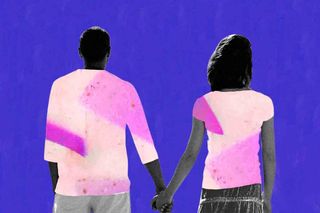
What Is a Lavender Marriage, And Why Is it Still Popular in India?
Our homophobia aside, perhaps, if we didn’t place family structures on a pedestal, lavender marriages would have been less common.

The ongoing hearings on marriage equality at the Supreme Court forced people to consider a rather pernicious peril that thrives in societies like ours, where social acceptance of queerness is lacking. It’s called a “lavender marriage” — this refers to heterosexual marriages of convenience between non-heterosexual individuals — or, at least, one non-heterosexual individual — that allow the couple to dodge the stigma surrounding queerness and, at times, also partake of the legal, social, and financial benefits of marriage. But a lavender marriage is rarely the preferred choice of a queer individual; often, it’s the last resort of a person struggling to cope with social and cultural pressures.
Anjana, a 23-year-old who had hidden her bisexuality from her family — among other things, like her decision to be childfree, and her love for music and dancing that can are still perceived as “unbecoming” of women from “respected” families — had told The Swaddle, “I would rather keep [parts of my life] hidden, than vocalize it and have to deal with their backlash… Constant comparisons to their idealized version of me, and the shame of not being able to be that person — just makes it difficult to live.”
In a span of less than two years, this is the second time that the topic of lavender marriages has become a part of public discourse in India. In 2022, it was prompted by the release of Badhaai Do — a movie about a gay man and a lesbian woman entering into a lavender marriage and keeping up appearances in a bid to earn themselves the freedom to pursue their romantic and sexual interests, separately — that has now gone on to win a number of coveted awards.
Some critics had argued at the time of Badhaai Do‘s release that the movie might do more harm than good to the LGBTQ+ community. “While Badhaai Do is being hailed for its depiction of homosexuality, the depiction of the lavender marriage could be problematic [in] normalizing this practice and sending out the message that a marriage of convenience is better than living a life of a gay person,” an article by the Firstpost warned. But more than a movie, it is Indian society’s stigma against queerness that has contributed to the popularity of lavender marriages in the country, and among the South Asian diaspora.
Related on The Swaddle:
Many Indian Families Express Care Through ‘Bullying,’ Creating Patterns of Abuse
That’s precisely what Saurabh Kirpal, a senior advocate, alluded to in his argument before the court, “If non-heterosexual [people] are prevented from marrying, what happens? In our society, lavender marriages would occur. Two lives would be ruined. There’s nothing more detrimental than a gay man marrying, and cheating a lady that way.”
Explaining how “lavender marriages are recipes for disasters,” reporter Nikhil Rampal wrote: “[A lesbian friend] told me about a gay man’s family willing to pay her for a ‘heterosexual marriage’ with their son. She also told me that patriarchy later kicks in such marriages, where the woman has to eventually face the brunt of the man’s family, abusive in-laws, and toxic masculinity from her husband. And there is always the expectation that having a child will ‘fix’ everything.”
It’s hardly surprising, then, that many documented lavender marriages throughout history have ended in divorce and separation and, sometimes, even contributed to a deterioration in the mental health of one or both partners. The secrecy and deception that becomes a permanent feature of anyone living a double life — irrespective of whether or not they’re in a lavender marriage — can trigger distress, making one feel as if they’re constantly “on the run.” Over time, it can manifest as depression, anxiety, and even identity crises induced by cognitive dissonance.
Our resistance to queerness — also reflected in the legal system’s refusal thus far to authorize non-heterosexual marriages — is an accessory to the mental health crisis among the queer population, which happens to be up to 2.4 times more vulnerable to mental health disorders, compared to the general population. We are living in a country where 56 million people are struggling with depression, and 38 million, with anxiety disorders — that queer individuals have it worse, is colossally jarring. The poor mental health outcome in the LGBTQ+ population is directly linked to the “higher stress” that results from “the stigma experienced by these minority groups,” research shows. To make matters worse, the fact that queer affirmative mental health services, too, are difficult to locate — as a result of the same societal stigma, of course — leaves many queer individuals without recourse.
Related on The Swaddle:
Not Everyone Idolizes Their Parents. Why Do We Inevitably Mirror Them Still?
Our homophobia aside, perhaps, if we didn’t place family structures on a pedestal, lavender marriages would have been less common. “Right from childhood, we are made to believe that acceptance from mainstream society is equivalent to upholding family honor. So in the case of serious life decisions like marriage, societal acceptance trumps being authentic to ourselves in order to not taint our family name… when you live in a society that cringes on homosexual relationships, which can lead to being disowned, mocked, or assaulted, it is very much fight or flight,” Aditya Khare, a prominent queer voice in India, told Hindustan Times.
The pedestalization of marriage reflects in the government’s economic policies, too, forcing queer individuals into marriages of convenience. “With the Indian state steadily withdrawing investments in social security (reflection of a trend world over), and disinvesting in education and healthcare, the task of care for the vulnerable, ill, disabled, and old has been entirely shifted onto the family unit,” writes Ketki Ranade, a genderqueer feminist academic and researcher, explaining why people are motivated to enter into lavender marriages in a society that relentlessly imposes the institution while denying queer individuals the opportunity the privilege of a legal union with their partners. “Because of the great emphasis on marriage as a marker of adulthood, consolidation of sexuality around ideas of individuated sexuality is less entrenched. In fact, marriage is seen as a bond between two families and not individuals,” Ranade adds.
As such, a lavender marriage often becomes the quick fix that allows queer individuals to live a respectable life without being ostracized, maintain a relationship with the families whose whims they have thus submitted to, and pursue their romantic interests without arousing suspicion.
Doing so, however, can set in motion an erosion of trust and intimacy in a marriage, which is quickly replaced by a dynamic of distrust and distance — inadvertently harming the very institution of marriage that our society puts on a pedestal.
Devrupa Rakshit is an Associate Editor at The Swaddle. She is a lawyer by education, a poet by accident, a painter by shaukh, and autistic by birth. You can find her on Instagram @devruparakshit.
Related


The Era of Vulnerability Comedy Is Here
